Mary Kay Bundle
How Did Mary Kay Build a Beauty Empire?
Journey back to 1963 and discover the inspiring story of Mary Kay Ash, a woman who revolutionized the cosmetics industry. With a mere $5,000 investment, she launched a company that would not only sell Mary Kay products but also empower women. This is the story of the Mary Kay company, a testament to entrepreneurial spirit and a unique business model.
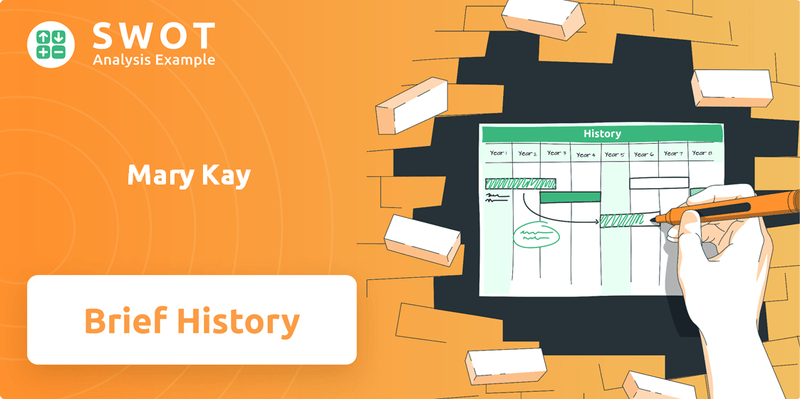
From its inception, the Mary Kay company, under the guidance of its founder, prioritized empowering women and offering them unparalleled opportunities. The Mary Kay history is filled with innovative direct selling strategies, which quickly set it apart from its competitors. Today, we will explore the brief history of Mary Kay, its significant milestones, and the lasting impact of Mary Kay cosmetics on the beauty industry and the world.
What is the Mary Kay Founding Story?
The story of the Mary Kay company begins on September 13, 1963, when Mary Kay Ash established her own venture. Before this, Mary Kay had a successful career in direct sales. However, she became frustrated by the limited opportunities for women in leadership. She envisioned a company where women could achieve success and be recognized for their efforts. This marked the beginning of a beauty empire.
Mary Kay Ash identified gender inequality in the workplace as a primary issue. She saw limited avenues for women to build careers and achieve financial independence. Her vision was to create a space where women could thrive. This led to the creation of a direct sales model that empowered women.
The Mary Kay history is rooted in a business model based on direct sales. Independent beauty consultants offered a flexible work environment. They could earn significant income through product sales and team building. The initial product line included skincare, developed from a formula she purchased. The company name, reflecting Mary Kay's personal commitment, was simply her own name. Initial funding came from Mary Kay Ash's personal savings of $5,000, with assistance from her son, Richard Rogers. This bootstrapping approach highlighted her determination.
Mary Kay Ash founded the company in 1963, addressing gender inequality in the workplace. The business model focused on direct sales, offering women financial independence. Initial funding came from personal savings and support from her son.
- Mary Kay Ash's vision was to empower women.
- The initial product offering was a skincare line.
- The company's name was derived from Mary Kay's own name.
- The early 1960s provided a fertile ground for her empowering message.
The cultural context of the early 1960s played a crucial role. Evolving roles for women and growing interest in self-improvement provided fertile ground. This environment supported Mary Kay's message and product offerings. The Mary Kay company quickly gained traction. The company's early success set the stage for its future growth and impact on the beauty industry.
The Mary Kay founder, Mary Kay Ash, built her company on the principles of empowering women. She aimed to provide them with opportunities for financial independence and recognition. The company's direct selling model was a key factor in its success. This approach allowed women to build their own businesses. The early years of the company laid the foundation for its future expansion. The company's focus on women's empowerment resonated with the cultural climate of the time. For more insights, check out the Marketing Strategy of Mary Kay.
Mary Kay SWOT Analysis
- Complete SWOT Breakdown
- Fully Customizable
- Editable in Excel & Word
- Professional Formatting
- Investor-Ready Format
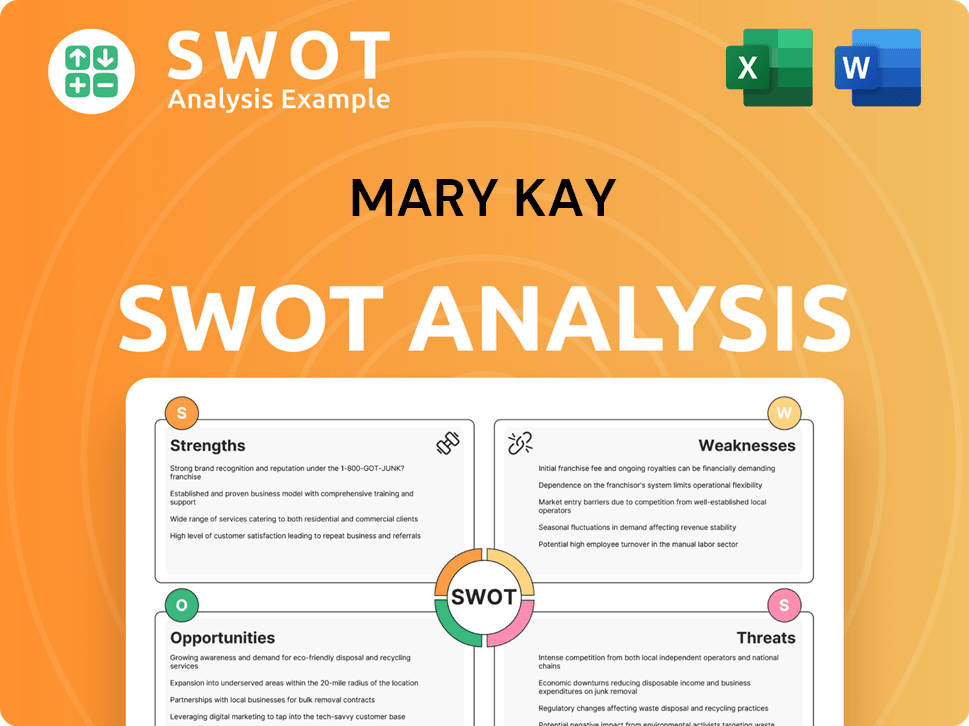
What Drove the Early Growth of Mary Kay?
The early years of the Mary Kay company were marked by rapid growth, fueled by its innovative sales approach and focus on empowering women. The initial product line centered on skincare, with the 'Miracle Set' becoming a cornerstone. This period saw the expansion of its independent beauty consultant network, offering women flexible work and financial independence.
The primary focus of Mary Kay cosmetics was on skincare. The 'Miracle Set' was a foundational offering, including products for cleansing, moisturizing, and protecting the skin. This set helped establish the company's reputation.
The company quickly built its network of independent beauty consultants. This model attracted women seeking flexible work and the opportunity for financial independence. The direct selling model was key to their growth.
In 1964, just a year after the company's founding, Mary Kay Ash hosted the first annual Seminar. This event has become a tradition, serving as a major motivational and training event for consultants. It continues to be a significant part of the company culture.
Early expansion involved recruiting and training independent beauty consultants. Mary Kay's business philosophy of empowering women was central to this effort. The first office and facility were established in Dallas, Texas.
The company's expansion began domestically, across the United States. The first international market was Australia, entered in 1971, followed by Canada in 1978. These expansions demonstrated the global appeal of Mary Kay products and the business opportunity.
Growth was largely fueled by reinvested earnings and commissions from the sales force. While specific early capital raises are not widely publicized, the direct selling model proved financially successful. The company's success was built on its sales force.
Leadership was primarily guided by Mary Kay Ash, with her son Richard Rogers playing a key role. The direct selling model offered a personalized customer experience. The market reception was overwhelmingly positive.
The competitive landscape included direct selling companies and traditional cosmetic brands. Mary Kay differentiated itself through its focus on women's empowerment. The company's focus on recognition and incentives, such as the pink Cadillac program, boosted morale and sales.
Mary Kay PESTLE Analysis
- Covers All 6 PESTLE Categories
- No Research Needed – Save Hours of Work
- Built by Experts, Trusted by Consultants
- Instant Download, Ready to Use
- 100% Editable, Fully Customizable
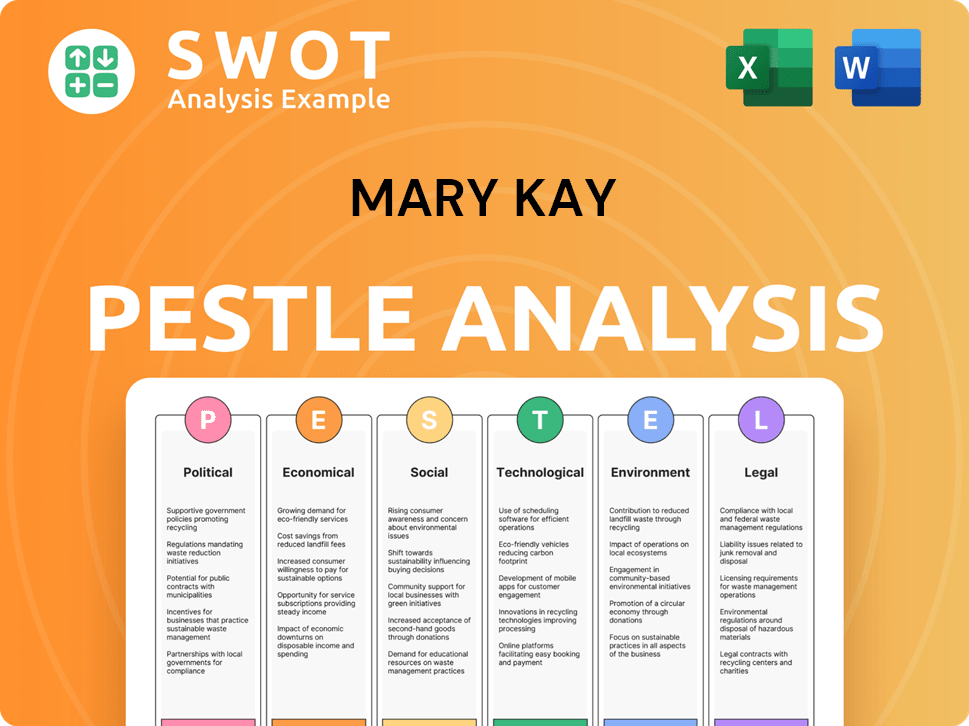
What are the key Milestones in Mary Kay history?
The Mary Kay history is marked by significant achievements and growth in the beauty industry. The Mary Kay company has established itself as a prominent player in the direct selling market, impacting the lives of countless women entrepreneurs worldwide. The company's journey, from its inception to its current global presence, showcases its adaptability and commitment to empowering women. Understanding the brief history of Mary Kay provides valuable insights into its success and enduring influence.
| Year | Milestone |
|---|---|
| 1963 | Mary Kay Ash founded the company with an initial investment of $5,000, focusing on a direct selling model. |
| 1968 | The company expanded internationally, beginning with Australia. |
| 1969 | Mary Kay Ash published her autobiography, "Mary Kay," which became a bestseller. |
| 1995 | The company launched its first website, embracing digital technology. |
| 2018 | Mary Kay celebrated its 55th anniversary, marking a significant milestone in its history. |
| 2023 | The company continued its commitment to sustainability and corporate social responsibility, with ongoing initiatives. |
A key innovation was its direct selling model, which allowed women to build their own businesses. Mary Kay cosmetics has consistently invested in research and development, leading to advanced product formulations and patented technologies, reflecting its commitment to quality and innovation.
This innovative business model empowered women to become independent entrepreneurs, offering them flexibility and financial opportunities. This approach set the stage for the company's success and its impact on the beauty industry.
The company has consistently invested in research and development, leading to advanced product formulations and patented technologies. This commitment to innovation ensures that Mary Kay products remain competitive and meet the evolving needs of consumers.
Embracing digital tools for consultants and expanding e-commerce capabilities has been a significant adaptation. This has allowed the company to reach a wider audience and enhance the customer experience.
The company's expansion into international markets, starting with Australia in 1968, has been a key factor in its growth. This global presence has allowed the company to diversify its revenue streams and reach a broader customer base.
Providing extensive training and support to its independent sales force has been a cornerstone of the company's success. This has helped consultants build their businesses and achieve their goals.
The company has been recognized for its commitment to sustainability and corporate social responsibility. This includes initiatives focused on environmental protection and community support.
The company has faced challenges such as economic downturns impacting consumer spending and competition from emerging beauty brands. Adapting to these challenges has involved strategic pivots, including embracing digital tools and expanding e-commerce.
Economic recessions and shifts in consumer spending patterns have impacted the demand for cosmetics and skincare products. The company has had to adjust its strategies to navigate these challenging economic climates.
Increased competition from new beauty brands and evolving retail landscapes has required the company to adapt its marketing and sales strategies. Staying competitive in the beauty industry is an ongoing challenge.
The need to embrace digital tools and e-commerce to complement the direct selling model has presented a challenge. The company has had to invest in technology and training to support its consultants in the digital space.
Managing and motivating a vast global independent sales force requires constant communication, support, and training. The company must maintain a strong connection with its consultants to ensure their success.
Global events and economic factors can lead to supply chain issues, impacting the availability of products. The company must manage its supply chain effectively to ensure product availability.
Changes in consumer preferences, such as the demand for natural and sustainable products, require the company to adapt its product offerings. The company must stay ahead of trends to meet consumer expectations.
Mary Kay Business Model Canvas
- Complete 9-Block Business Model Canvas
- Effortlessly Communicate Your Business Strategy
- Investor-Ready BMC Format
- 100% Editable and Customizable
- Clear and Structured Layout
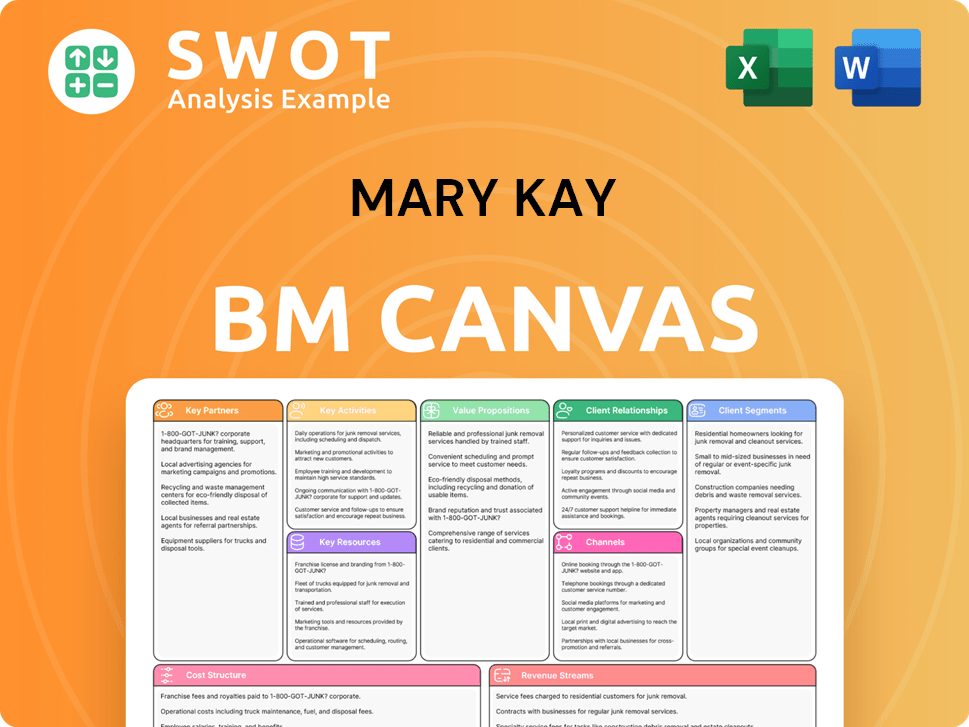
What is the Timeline of Key Events for Mary Kay?
The Mary Kay history is a story of entrepreneurial spirit and empowering women. The company's journey from its humble beginnings to a global beauty giant is marked by significant milestones and a distinctive business model.
| Year | Key Event |
|---|---|
| 1963 | Mary Kay Ash founded the company in Dallas, Texas, with an initial investment of $5,000, focusing on a direct-selling model. |
| 1964 | The first independent sales force was established, and the company's signature pink Cadillac incentive program began. |
| 1968 | International expansion began with the launch in Australia. |
| 1969 | The company went public, marking a significant step in its growth. |
| 1985 | The company was taken private by Mary Kay Ash and her family. |
| 2001 | Mary Kay Ash passed away, leaving a legacy of empowerment and entrepreneurship. |
| 2018 | The company celebrated its 55th anniversary, continuing its global presence. |
The company continues to expand its global footprint. Currently, it operates in over 35 markets worldwide. This expansion strategy is expected to continue, with a focus on emerging markets. This growth is fueled by the direct selling model and a commitment to localized marketing strategies.
The company is investing in product innovation, including skincare and color cosmetics. Sustainability is becoming a key focus, with initiatives aimed at reducing environmental impact. This includes sustainable sourcing and eco-friendly packaging, reflecting consumer demand for environmentally conscious products.
The company is enhancing its digital presence and e-commerce capabilities. This includes improving online sales platforms and leveraging social media. They are also focusing on providing digital tools and training for their independent sales force to enhance their business. These efforts are aimed at adapting to changing consumer behaviors.
The company is reinforcing its direct-selling model by providing more support to its independent sales force. This includes enhanced training programs and business tools. They are also focusing on creating a more flexible and inclusive business environment. These efforts aim to attract and retain a diverse sales force.
Mary Kay Porter's Five Forces Analysis
- Covers All 5 Competitive Forces in Detail
- Structured for Consultants, Students, and Founders
- 100% Editable in Microsoft Word & Excel
- Instant Digital Download – Use Immediately
- Compatible with Mac & PC – Fully Unlocked
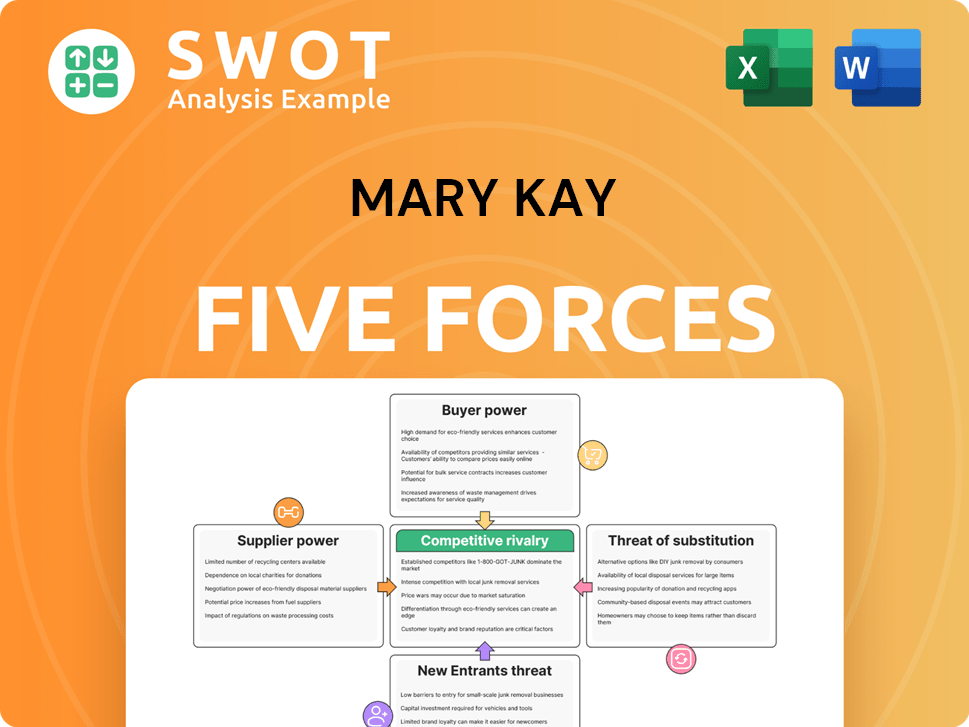
Related Blogs
- What is Competitive Landscape of Mary Kay Company?
- What is Growth Strategy and Future Prospects of Mary Kay Company?
- How Does Mary Kay Company Work?
- What is Sales and Marketing Strategy of Mary Kay Company?
- What is Brief History of Mary Kay Company?
- Who Owns Mary Kay Company?
- What is Customer Demographics and Target Market of Mary Kay Company?
Disclaimer
All information, articles, and product details provided on this website are for general informational and educational purposes only. We do not claim any ownership over, nor do we intend to infringe upon, any trademarks, copyrights, logos, brand names, or other intellectual property mentioned or depicted on this site. Such intellectual property remains the property of its respective owners, and any references here are made solely for identification or informational purposes, without implying any affiliation, endorsement, or partnership.
We make no representations or warranties, express or implied, regarding the accuracy, completeness, or suitability of any content or products presented. Nothing on this website should be construed as legal, tax, investment, financial, medical, or other professional advice. In addition, no part of this site—including articles or product references—constitutes a solicitation, recommendation, endorsement, advertisement, or offer to buy or sell any securities, franchises, or other financial instruments, particularly in jurisdictions where such activity would be unlawful.
All content is of a general nature and may not address the specific circumstances of any individual or entity. It is not a substitute for professional advice or services. Any actions you take based on the information provided here are strictly at your own risk. You accept full responsibility for any decisions or outcomes arising from your use of this website and agree to release us from any liability in connection with your use of, or reliance upon, the content or products found herein.